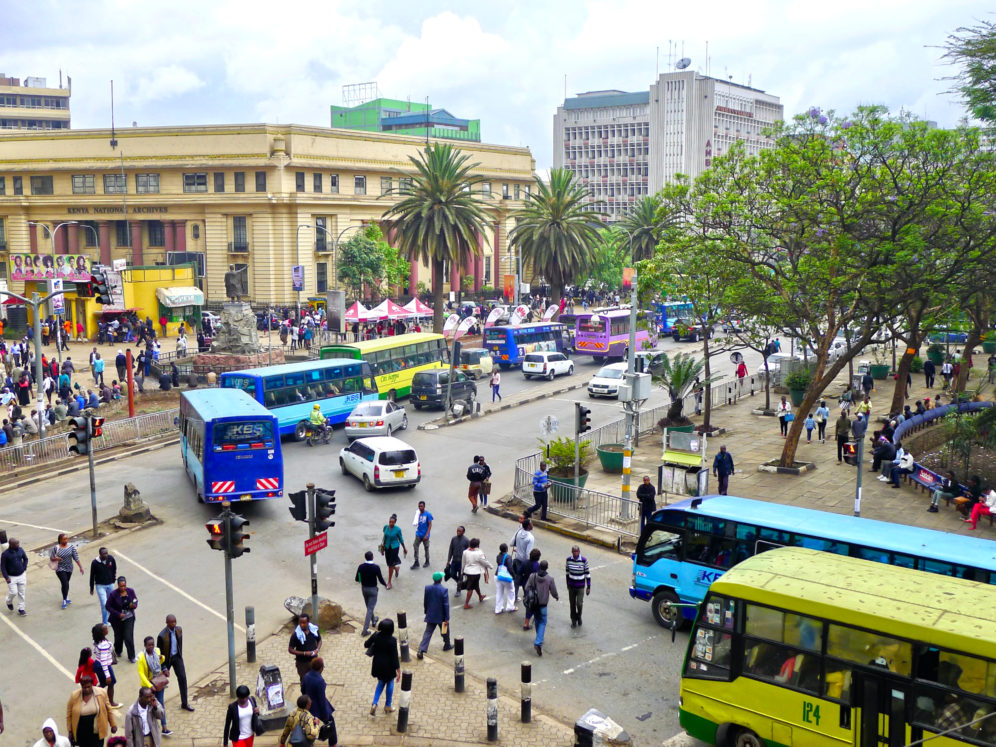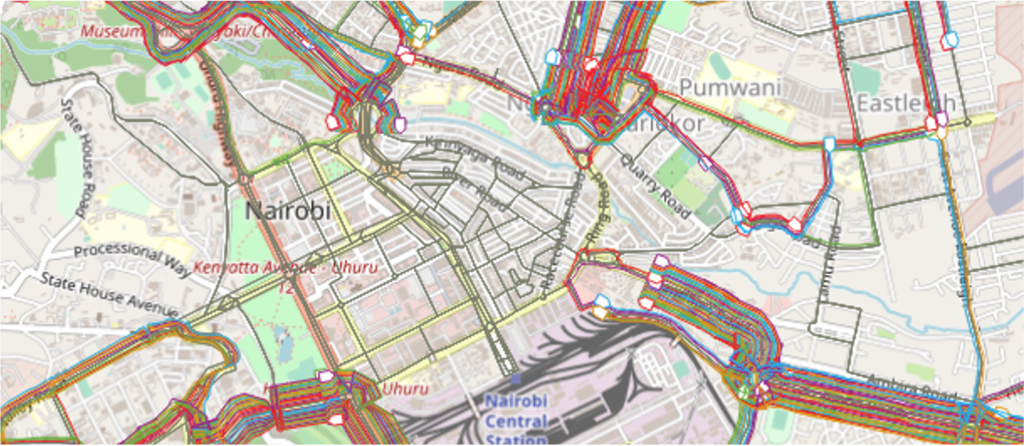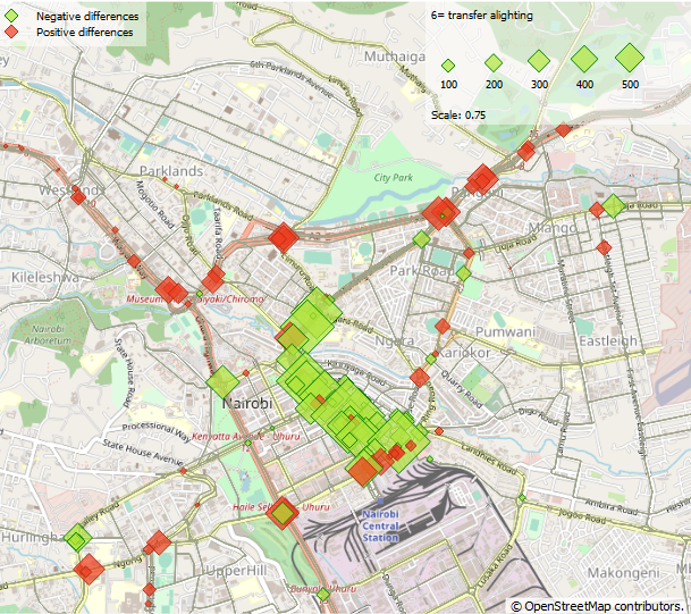
November 20, 2020
Better than a ban: Prioritising efficient public transport in the Nairobi CBD
In an attempt to ease congestion, Nairobi Metropolitan Services (NMS) intends to ban matatus from accessing the central business district of Kenya’s capital by the end of April 2022. Yet questions linger as to why public transport should be banned when personal motor vehicles are the real cause of congestion in the city.
The plan involves constructing several bus terminals in the outskirts of the city centre. Matatus plying Thika Road and long-distance vehicles from the Mt. Kenya region would need to end their trips at the Desai and Park Rd terminals in Ngara. Public service vehicles (PSVs) plying Ngong and Langata Rd would terminate at the Green Park Terminal at the former Railways Club. Matatus from South B, South C, Mombasa Rd, and Athi River would end their trips at a new terminal at Bunyala and Workshop Rd. The Fig Tree terminal would serve matatus from Limuru Rd and Waiyaki Way, while the Muthurwa terminal would serve matatus plying Jogoo and Lusaka Rd.
Over the years, there have been several futile attempts to restrict public transport access in the city centre. In 2009, the Nairobi City Council attempted to ban PSVs from the CBD. However, pressure from transport workers halted the plan. The plan was also floated by Nairobi’s first Governor in 2013, but was never actualised. In 2018, the serving Governor, Mike Sonko, banned matatus from the CBD and insisted that apart from decongesting the city, the ban would ensure that residents were active and fit. He was forced to lift the ban due to public outcry. The resulting increase in private vehicles led to traffic chaos on some streets, while other arteries entering the CBD turned into de facto pedestrian zones, full of commuters making the trek from public transport halting points into the city centre.


Proposed matatu ban: Longer trips for commuters
In Nairobi, public transport planning is often viewed as a traffic management problem, but sound management of the public transport sector instead should focus on the needs of passengers. In 2018 and 2019, ITDP in collaboration with the Nairobi Metropolitan Area Transport Authority (NaMATA) gathered transport data to assess the movements of public transport passengers across the Nairobi metropolitan area. The data collection exercise included bidirectional frequency-occupancy surveys at 92 locations, boarding and alighting surveys on 131 matatu routes (sampling 947 one-way journeys), and 4,621 interviews of matatu passengers. From the resulting data, ITDP developed a travel demand model that can be used to assess the impact of changes in the public transport network.
By shifting transfer terminals further apart, the proposed matatu ban would increase the average walking time for passengers who transfer within the CBD from 15 to 31 minutes. The increased walk time would be particularly difficult for passengers traveling with children, persons with disabilities, and commuters carrying luggage. Press reports have mentioned the prospect of shuttle buses to ferry passengers from one terminal to another—yet such services would lead to increased waiting time for the transfers and additional fares, among other inconveniences for passengers. It is also not clear who will provide the shuttle services.
Planning with the needs of commuters in mind
The high volume of PSVs in the Nairobi CBD is a result of the radial pattern of the existing public transport network, where almost all matatu routes originate from the city centre. The existing arrangement makes cross-town trips more expensive and time consuming. Analysis of matatu passenger trips shows that 42 percent of passengers transfer at least once in order to reach their destinations. Measures to restructure public transport services should aim to reduce the number of transfers and improve convenience for commuters.
As a more efficient and attractive alternative, Nairobi could introduce new cross-town routes to serve high-demand corridors. Using the travel demand model to test possible scenarios for more efficient routes, we identified 27 high-demand cross-town routes that if introduced would carry 43 percent of total public transport demand in the city. These cross-town services would eliminate the need to transfer for 156,000 passengers each day. Besides improving convenience for commuters, direct services would reduce matatu volumes in the CBD—without the disruption of a full ban.

Prioritising public transport
Proposals to decongest Nairobi usually target public transport, yet private vehicles occupy the majority of road space in the city centre. In Nairobi, only 13 percent of commuters travel by car, compared to 41 percent who use public transport and 40 percent who walk. To successfully decongest the city, public transport should be prioritised, complemented by universally accessible non-motorised transport facilities for better pedestrian and cycle access.
In Dar es Salaam, the bus rapid transit (BRT) project brought about the reconfiguration of Morogoro Rd, an important but narrow corridor in the downtown area. The street was repurposed for exclusive use by mass rapid transit, cyclists, and pedestrians. Private vehicle access and parking slots were removed, freeing up space for walking and social gathering

Transitioning from matatus to high-capacity public transport buses as part of a BRT system would transform the public transport experience in Nairobi, saving time, reducing commuting costs, and encouraging city residents to use public transport as a more efficient alternative to private vehicles. Wider footpaths, dedicated cycle tracks, and bikeshare stations should be introduced to improve last-mile connectivity and encourage the use of nonpolluting modes.
With an efficient public transport system in place, the city should enforce measures to discourage private vehicle use. Parking fees should be set based on demand, creating an incentive for car users to avoid city areas that experience the most congestion. Enhanced parking management also would generate funds that could be invested in an accessible, efficient, and equitable public transport system. By prioritising sustainable modes, Nairobi can address the challenge of congestion while meeting the needs of the majority of city residents.
